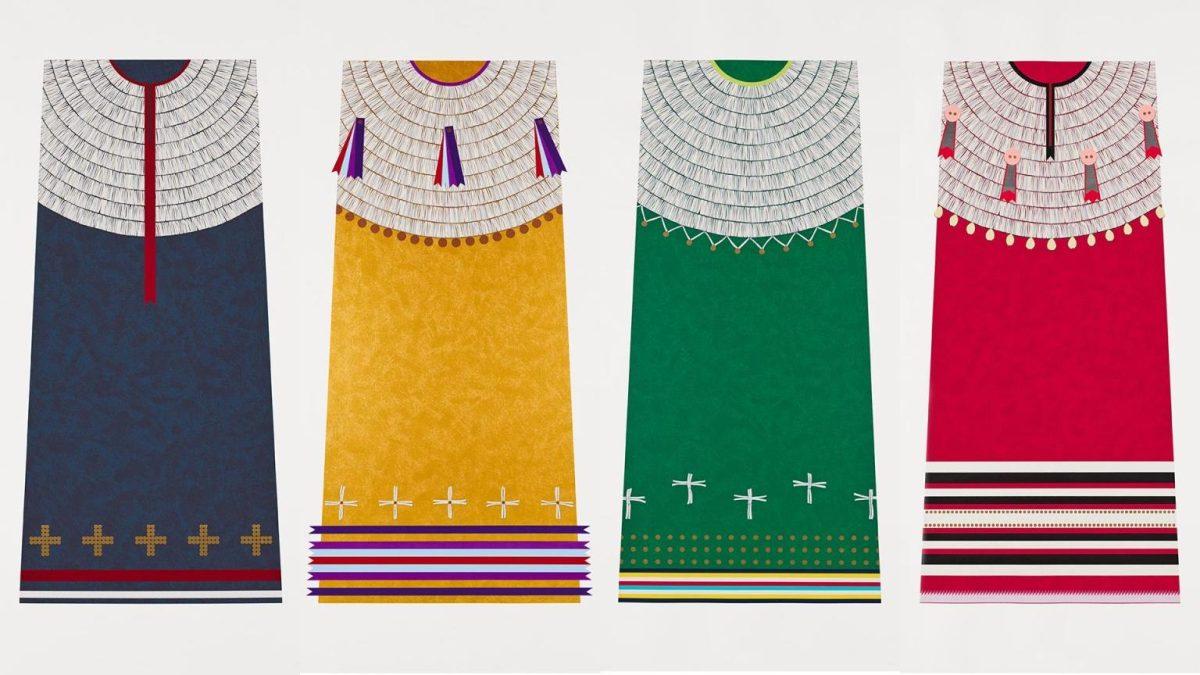On Sunday, Dec. 2, Wellesley’s Native American and Indigenous Student Association (NAISA) visited the Native American exhibit at the Museum of Fine Arts and attended the latest lecture commemorating the Museum of Fine Arts’ collection, “Marking Resilience: Indigenous North American Prints” featuring Native American artist, Dyani White Hawk (Sičáŋǧu Lakota). She discussed her works and how through them she advocates for Native American women. Her featured works in the collection include “Wówahokuŋkiya | Lead, Wókaǧe | Create, Nakíčižiŋ | Protect and Wačháŋtognaka | Nurture” from her Takes care of Them suite.
The suite includes four prints of traditional northern plains dresses that draw inspiration from the Sioux dress with a dentalium shell yoke in the Smithsonian Museum. White Hawk meticulously studied dresses at the Smithsonian for 10 days and then asked her friends to send videos of them in their dresses to observe the fabric movement. Then, when she was creating her piece, White Hawk was advised to start small and with one yoke. However, she insisted that in the end, she would still need four to satisfy her ambitions and properly represent all the figures in her life.
“They are very unique. They are very tied to the lineage of my work and my practice, but they are unique in that they are more representative of real-life objects than my work tends to be … They would have only existed through the opportunity to make prints,” White Hawk said.
Although the work specifically serves as an ode to her veteran mother, White Hawk celebrates all female figures. White Hawk notes that Native American communities have the most veterans per capita, even after considering their history with colonialism. Fallen soldiers and veterans are often honored in the community for their sacrifices and protection. White Hawk’s prints are closely related to her relationship with her family, specifically, the women who should be honored like soldiers.
“I was thinking about the ways non-military veterans also do this. I kept thinking about how our female relatives stand guard and protect our communities in various ways; they bring, nurture and protect life. [In general], all of the ways our female relatives contribute to the protection, continuity and preservation of our communities, cultures, families and individuals. For me, that is what this series is about, recognizing how women protect our communities in ways I feel at times are equal … to our veterans,” White Hawk said.
White Hawke noted that the prints represent a diverse variety of women in her life and community, both as individuals and in their collective role as members and protectors.
“When I look at those four prints I think about them in relational terms, as certain ages, certain personalities within a community. It is also representative of different times and eras. So the navy blue one is like the grandma since it references an older style of adornment,” White Hawk said.
From left to right, White Hawk relates the garments to her grandmother, an older but blinged-out auntie, mother and another auntie. Despite their differences, the garments all include quillwork, a traditional northern Native American practice. White Hawk’s work is also one of the only prints in the collection that includes this traditional practice. Quillwork is one of White Hawk’s favorite art mediums, however, when she transitioned from a school for Native American students to a traditional American institution she felt conflicted about whether she could continue her practice.
“I thought that if I started making a pair of moccasins I would have to conceptually justify them as a part of my practice and as a part of my studio practice; that just felt wrong to me because I did not feel like I needed to fight that fight. I knew why they were valuable. I knew why it was important,” White Hawk said.
She eventually gave in and brought quillwork to her graduate school work. Unfortunately, quillwork required a lot of labor and White Hawk needed to figure out how to fit it into the “academic calendar.” She focused on how to balance the contradicting value systems of embracing home and still doing graduate work that she can be proud of.
White Hawk was recently awarded the McArthur Fellowship, which is commonly known as the “genius grant.” Today, her art utilizes mixed media to combine painting with Native American art forms to preserve and protect Native American culture. Much like the women she wants to honor, White Hawk preserves her community through her specialty in art.




